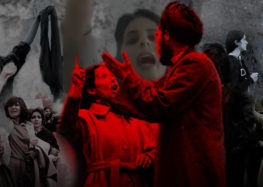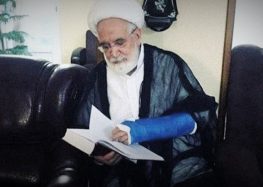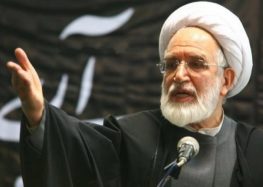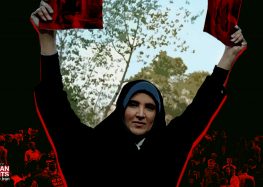Authorities Unleash a Wave of Violence Against Demonstrators
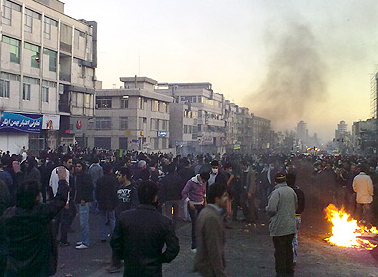
Photo courtesy of BBC Persian
(14 February 2011) Iranian security forces should end the use of excessive force, intimidation, and arbitrary arrest against peaceful demonstrators said the International Campaign for Human Rights in Iran today. The Islamic Republic is openly violating freedom of assembly in Iran, while claiming to support it in Egypt.
Today, 14 February 2011, thousands of demonstrators came out in Tehran and other major Iranian cities, in what organizers called a rally in solidarity with protestors in Egypt and Tunisia. However, Iranian security forces suppressed demonstrations across the country, reportedly attacking crowds with tear gas, paint bullets, sticks, electric batons and live ammunition. There were reports that one demonstrator was killed.
Several eyewitnesses told the Campaign that they observed security forces and plainclothes agents attack and disperse groups of demonstrators in between Ferdowsi and Enghelab squares in Central Tehran.
“Today’s crackdown leaves no doubt that the Iranian government is determined to suppress its opponents at any cost by mobilizing a large number of police forces, Basiji militants and undercover intelligence to violently silence people seeking to exercise their legitimate right to assembly,” said Aaron Rhodes, a spokesperson for the Campaign.
“The demonstrators in Iran came out because they were reenergized by events in Egypt and Tunisia. Now the Iranian government, who chastised Mubarak for not respecting the rights of Egyptian protestors, is using intimidation, violence, and detention to stop their own citizens expressing themselves in the streets,” Rhodes added.
A journalist inside Iran told the Campaign, “I was so engrossed in watching the people chanting their spontaneous slogans, I did not see [security] forces suddenly descended upon the crowd from behind me. People were running toward Enghelab Square in order to avoid getting beaten with batons. I lost my balance and fell down. [Then] I had a strange burning sensation on my right shoulder.”
“First I thought I was shot,” continued the journalist. “A hand reached out from nowhere and picked me up like a straw and saved me from the stampede of the frightened crowd. I don’t know who it was, because immediately thereafter, a cloud-like mass overtook everything and my eyes closed from the sting of teargas. I could hear the teargas shots and bullets fired into the air and Enghelab Avenue felt like the 1979 revolutionary. I tried to reach my right shoulder, as it was burning painfully. When I removed my hand it was not bloody. I realized then that my shoulder was burning because it had been hit by an electric baton.”
An activist told the Campaign that two Internet activists in Tehran that helped mobilize the protests were reportedly taken to the hospital from beatings by security personnel, but then allegedly went missing. Eyewitnesses also told the Associated Press that some people were taken to the hospital for severe injuries caused by bullets.
In an apparent effort to undercut the demonstration effort, security forces in major cities across Iran have reportedly detained numerous activists and demonstrators. Authorities also allegedly detained two student activists, Mohsen Barzegar and Hossein Zamen Zarrabi, taking them to an unknown location. Kaleme website also reports that on the evening of 14 February, security forces stormed the homes of Ali Bagheri of the Islamic Mujahedin Organization’s Central Council, and Abdollah Nasseri, another member of the organization and former head of the Islamic Republic News Agency during the Khatami administration, and detained them. This continues a government crackdown on opposition that began in the days leading up to today’s demonstrations.
Previously, Iranian authorities refused to issue an assembly permit for the planned demonstration. The Campaign called upon the Iranian government to respect the right to peaceful assembly and to stop arbitrary arrests on the threshold of 14 February.
Today, security forces surrounded the homes of several reformist politicians. Former President Mohammad Khatami and Abdollah Nouri, Interior Minister during Khatami’s administration, were unable to leave their homes as forces surrounded them.
Since last Thursday, security forces have had the home of former speaker of the parliament Mehdi Karroubi surrounded. This morning, surveillance cameras around Karroubi’s home were allegedly tampered with to stop working. Authorities have blocked the streets leading to the homes of the opposition leaders Mir Hossein Moussavi and Karroubi with police vehicles and plainclothes forces, and disconnected their phone lines. Moussavi and Karroubi and their wives were not allowed to leave their homes to join the demonstrations.
Shortly before the start of demonstrations at 3:00 p.m., both Kaleme website, close to Moussavi, and Saham News, affiliated with Karroubi, became inaccessible. Also, Balatarin, a website frequently updated with news of the protests, became frequently inaccessible.
The 14 February gatherings were not limited to Tehran. Demonstrators in Isfahan, Shiraz, Kermanshah, and Gilan province came out in significant numbers. In Tehran, large numbers of demonstrators reportedly turned out on Azadi Avenue, Imam Hossein Square, Enghelab Avenue, Vali-e-Asr Avenue, Sadeghieh Square, College Square, and Ferdowsi Square. There were clashes between demonstrators and plainclothes and Special Police Forces in those locations. Despite the widespread presence and reported use of force by plainclothes agents and anti-riot police, demonstrations continue into the night.
“The government of Iran’s intolerance for independent public demonstrations is shocking,” said Rhodes. “Authorities should immediately put an end to the repression of these demonstrations and Iran’s allies should insist upon the same respect for human rights in Iran as was expected from Egypt.”

